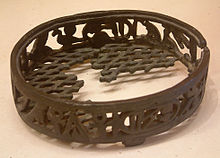Meriibre
| Name of Meri-ib-re | |||||||||||||||||||||||||||||||||
|---|---|---|---|---|---|---|---|---|---|---|---|---|---|---|---|---|---|---|---|---|---|---|---|---|---|---|---|---|---|---|---|---|---|
| Horus name |
Mr.j-jb-t3.w (j) Beloved in the two countries
Mr.j-jb-t3.w (j) Beloved in the two countries |
||||||||||||||||||||||||||||||||
| Sideline |
Mr.j-jb-t3.w (j) Beloved in the two countries |
||||||||||||||||||||||||||||||||
| Gold name |
Bjk-nbw-mr.j Beloved Golden Falcon (?) |
||||||||||||||||||||||||||||||||
| Throne name |
Mr.j-ib-Rˁ With loving hearts, a Re
Mr.j-jb-Rˁ With loving hearts, a Re |
||||||||||||||||||||||||||||||||
| Proper name |
ẖtj Divine ruler
S3-Rˁ ẖtj Son of Re , Cheti |
||||||||||||||||||||||||||||||||
| Royal Papyrus Turin (No. IV./24) |
Meri ... Mr.j ... |
||||||||||||||||||||||||||||||||
Meriibre (also Meri-ib-Re ) is the throne name of an ancient Egyptian king ( Pharaoh ) of the 9th Dynasty ( First Intermediate Period ).
supporting documents
From a Meri-ib-Re Cheti there is a brazier in the Louvre , a stick from Meir and a few other small objects that may be attributed to this king.
The ruler's placement in Egyptian chronology is not certain.
For example, the name of the 5th king (... znn ...) on the papyrus has been destroyed.
literature
General
- Thomas Schneider : Lexicon of the Pharaohs . Albatros, Düsseldorf 2002, ISBN 3-491-96053-3 .
- Institut français d'Égypte (ed.): Annales du Service des Antiquités de l'Egypte. Volume 10, Cairo 1900, pp. 185-186.
- Proceedings of the Society of Biblical Archeology. London 1879-1918, Volume 13, pp. 429-431.
- William C. Hayes : The Scepter of Egypt. Metropolitan Museum of Art, New York 1953-1959, Volume 1, ISBN 0-87099-190-6 , p. 143, Figure 86.
- Jürgen von Beckerath : Handbook of the Egyptian king names . Deutscher Kunstverlag, Munich-Berlin 1984, ISBN 3-422-00832-2
- Farouk Gomaà : Egypt during the First Intermediate Period (= supplements to the Tübingen Atlas of the Middle East. Series B: Geisteswissenschaften. Vol. 27). Reichert, Wiesbaden 1980, ISBN 3-88226-041-6 , pp. 130-135
- Jürgen von Beckerath: Journal for Egyptian language and antiquity. No. 93, 1966, pp. 13-20.
- Wolfgang Schenkel in: Lexicon of Egyptology . Harrassowitz, Wiesbaden 1975, ISBN 3-447-04468-3 .
- Winfried Barta: Journal for Egyptian Language and Archeology. No. 108, 1981, pp. 23-33.
- Louise Gestermann: Continuity and change in politics and administration of the early Middle Kingdom in Egypt (= Göttinger Orientforschungen. IV. Egypt series . Volume 18). Harrassowitz, Wiesbaden 1987, ISBN 3-447-02728-2 , pp. 17-21.
- Joachim-Friedrich Quack: Studies for teaching for Merikare . Harrassowitz, Wiesbaden 1992, ISBN 3-447-03226-X .
- Ewa Rowinska, Jan Krzysztof Winnicki: Journal for Egyptian Language and Classical Studies. No. 119, 1992, pp. 130-143.
Remarks
- ↑ The hieros for "Sa-Re" are inside the cartridge
Individual evidence
- ^ Alan H. Gardiner: The royal canon of Turin. Griffith Institute, Oxford 1997, ISBN 0-900416-48-3 , illustration 2.
| predecessor | Office | successor |
|---|---|---|
| Neferkare III. |
Pharaoh of Egypt 9th Dynasty |
Neferkare Cheti III. |
| personal data | |
|---|---|
| SURNAME | Meriibre |
| ALTERNATIVE NAMES | Meri-ib-Re |
| BRIEF DESCRIPTION | ancient Egyptian pharaoh |
| DATE OF BIRTH | 22nd century BC Chr. |
| DATE OF DEATH | 22nd century BC Chr. |

